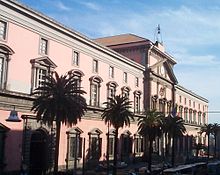Museo archeologico nazionale di Napoli
| Museo Archeologico Nazionale di Napoli | |

Façade of the museum
|
|
| Established | 1777 |
|---|---|
| Location | Piazza Museo 19, Naples Italy |
| Type | archaeology |
| Collections | Romans, Greeks, Egyptians |
| Visitors | 500.000 (2017) |
| Director | Paolo Giulierini |
| Public transit access | Fermata Museo (Metropolitana linea 1) Fermata Piazza Cavour (Metropolitana linea 2) |
| Website | Official website |
The National Archaeological Museum of Naples (Italian: Museo Archeologico Nazionale di Napoli, sometimes abbreviated to MANN) is an important Italian archaeological museum, particularly for ancient Roman remains. Its collection includes works from Greek, Roman and Renaissance times, and especially Roman artifacts from nearby Pompeii, Stabiae and Herculaneum. It was formerly the Real Museo Borbonico ("royal Bourbon museum").
The building was built as a cavalry barracks in 1585. From 1616 to 1777 it was the seat of the University of Naples. During the 19th century, after it became museum, it suffered many changes to the main structure.
The museum hosts extensive collections of Greek and Roman antiquities. Their core is from the Farnese Collection, which includes a collection of engraved gems (including the Farnese Cup, a Ptolemaic bowl made of sardonyx agate and the most famous piece in the "Treasure of the Magnificent", and is founded upon gems collected by Cosimo de' Medici and Lorenzo il Magnifico in the 15th century) and the Farnese Marbles. Among the notable works found in the museum are the Herculaneum papyri, carbonized by the eruption of Mount Vesuvius, found after 1752 in Villa of the Papyri.
...
Wikipedia
